Fabio Zonin, StrongFirst Certified Master Instructor, and I independently discovered and practiced the same movement: a standing forward kettlebell press with a static hold. When I described it to Fabio and sent him a video, Fabio said, “Hey, I do that, too!” and subsequently Fabio invited me to discuss the new kettlebell exercise on an edition of his weekly Facebook Italy Live presentation, Strength Pills. Fabio Fogato, StrongFirst Certified SFG II, SFL, and SFB Instructor, participated in the discussion as well. I will provide a link at the end of this article for anyone wishing to explore the movement in more detail.
How to Get Started with the Forward Press
Hold a light kettlebell in the rack position just as you would for an overhead press. I recommend no more than 8kg for men to start and 4kg for women. Currently, I use a 6kg or 8kg for this movement for moderate reps and a 10kg or 12kg for low reps. Fabio uses a 12kg and a 16kg, respectively. More about weight selection later. For now, start light.
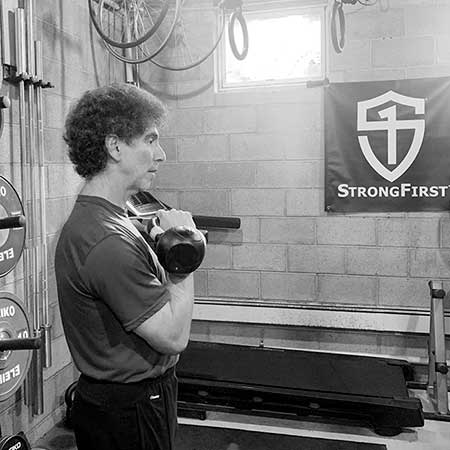
As explained in VICTORIOUS (Fabio’s kettlebell course on the overhead press), execute GLAG—tighten your Grip, Lats, Abs, and Glutes. At no more than a moderate speed, press the kettlebell away from you to the front. Do not execute this movement quickly. Slow and controlled is the order of the day here.
Pause at the lockout, which should look like the finish of a punch. The kettlebell will be resting on the back of your forearm. The line of your knuckles should be approximately parallel to the ground and the ball of the kettlebell should be slightly below shoulder height—more on this later. You may hold this position briefly or up to several seconds, but you must hold it without undoing any aspect of GLAG and especially without unpacking your shoulder. Return the kettlebell to the rack position. If you’ve done this correctly, executing another GLAG should not cause anything to move, but execute it anyway, just to be sure. If you unpacked your shoulder during the press, please focus on correcting that as you continue your practice.
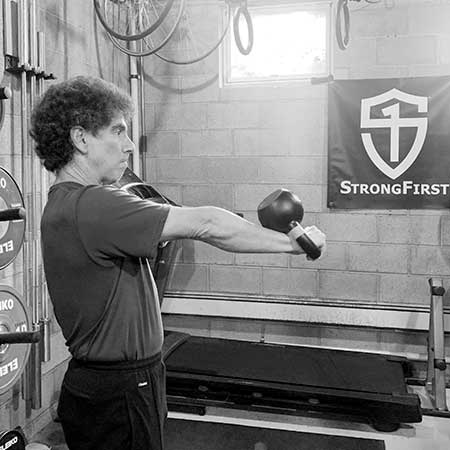
Body Position
Your body must be in a vertical plank the entire time. Pressing a weight out to arm’s length in front of you changes your center of mass, which could cause you to shift your weight to the front of your feet or even to fall over forwards. You may lean back, but you must do so only from the ankles—everything above your ankles must remain locked in place.
Arm Angle—To The Ground
The angle of your arm to the ground is important. You are looking for the most difficult place in which to support the weight, which is with the center of the kettlebell lined up with the center of your shoulder joint. Since you can only see the top of your shoulder joint, not the center, you will aim for a point that looks a little lower than parallel—this is where what we’ll call “functional parallel” lies.
Many confuse the top of the shoulder with the center of the shoulder joint. In order to understand where the center of your shoulder joint is, you can use this drill by Fabio Fogato: place the palm of one hand on top of your opposite shoulder. Make sure your fingers, from the index to your pinky, are glued together. Place your index finger on top of your acromion, the bone that you can feel on top of your shoulder. The spot in which your pinky is placed roughly indicates the center of your shoulder joint. This is where you want to aim to be parallel with at the lockout.
Arm Angle—To Your Body
You may experiment with the forward angle at which you press the kettlebell away from your body but don’t do anything extreme as this will do the wrong kinds of things to your shoulders. Press straight out in front of you. Now imagine a circle around the kettlebell with a radius of 6-8 inches (15-20cm)—do not go further than the outside edge of that circle. Over time gently explore what might incorrectly be called “internal shoulder rotation.” The ideal finishing point is where you are supporting the kettlebell on your forearm with the line of your knuckles approximately parallel to the ground. Rotate no further than keeping your shoulder tightly packed will allow.
Programming
You can use this movement in a variety of ways. With a light weight, you may perform the forward press as an assistance/hypertrophy exercise for your shoulders, generally in the 8-15 rep range after any main shoulder work is done for the day. A heavier weight, if you can manage it safely, in the higher rep range is also okay, as are multiple sets of various rep ranges. With a moderate weight, you may treat it as prehab/rehab, keeping the rep range moderate (3-5 on the low side and 8 on the high side) and perform a single set with each hand before other exercises. This is my preferred practice.
More Performance Tips
As you are pressing the kettlebell towards the lockout, your scapula will try to shrug. Do not allow this to happen. Keeping your shoulders pressed “away from your ears” during the movement will improve your ability to keep your shoulders connected during your military press and other overhead movements. It will also help the bench press and the floor press section of the get-up.
As the kettlebell moves away from your body your delts generate greater tension and tend to compress your humeral head against the glenoid and the acromial roof. This is one of the most common issues for bodybuilders who develop their massive deltoids through dumbbell lateral raises. It happens mostly when they tend to “cheat up” the dumbbells too fast. Performing the forward press slowly and under control will allow some muscles located on your scapula, the SITS (supraspinatus, infraspinatus, teres minor, and subscapularis), aka the “rotator cuff” muscles, to come into play and stabilize your shoulder joint. Strong SITS muscles lead to strong and healthy shoulders. There are many specific exercises for your SITS, but most of them, while appropriate for strengthening a weak rotator cuff, aren’t enough for a strong athlete. The forward press trains the SITS muscles for exactly what their purpose is: stabilizing a joint while it’s moving.
With a heavy weight, you can use this to build shoulder strength by keeping the reps low, but program this carefully to not interfere with other shoulder-centric exercises. And expect your “Dear Abbies” to be tired from the correct performance of this movement. Just as with the one- and two-arm kettlebell swing, this movement can be performed with one kettlebell or two kettlebells, one in each hand. Remember to start with a light weight. But as with the swing, if you had to choose only one, choose the single kettlebell for the resilience the unbalanced load will bring to your midsection.
Conclusion
The forward press works the cross chain that runs between the pressing arms and the opposite side’s foot, which will strengthen the body’s ability to resist rotational forces. Another benefit is that keeping the shoulder packed while moving the arm will address “winged scapula.” And yet another benefit is that the “lean back only from the ankles” technique will strengthen the quadratus lumborum and other muscles in the thoraco-lumbar band. An interesting variation, after you’ve used the forward press for a while, would be to reach the lockout not by pressing from the rack but rather by lowering a straight arm from the top of an overhead press. One could then, by carefully monitoring the stopping point, load the exercise more heavily. I hope the forward press will be a welcome addition to your training arsenal. Use it as prehab, a warmup, or even as a main course for your shoulders, and report your findings on the StrongFirst Forum.
Now as promised, here is the link to the Pills of Strength program where the forward press is discussed in more detail.
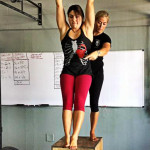
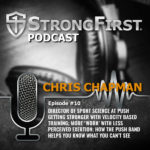
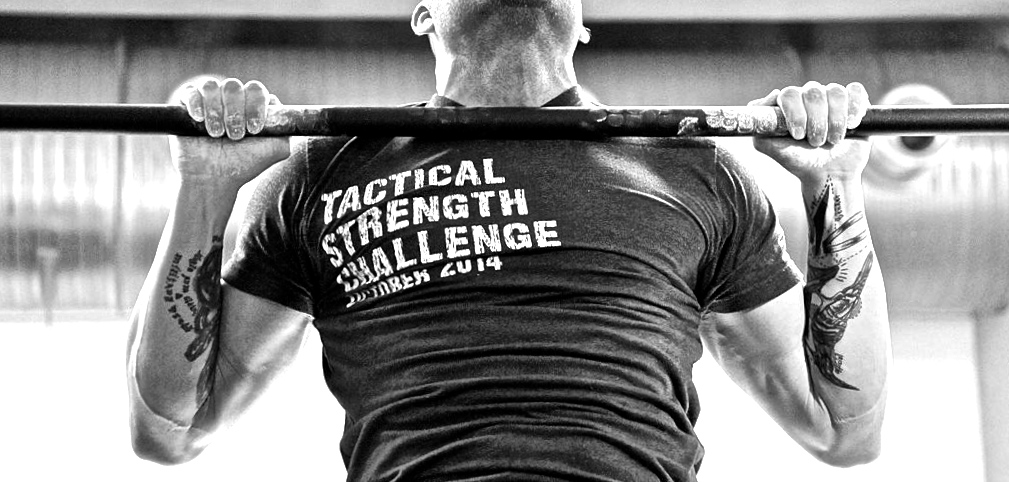


Excellent, I look forward to incorporating this into my current rehab routine!
Good stuff! Well executed and written! First time I’ve witnessed this exercise. Keep up the great work!